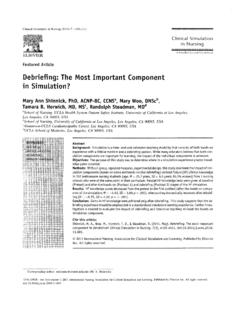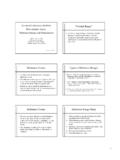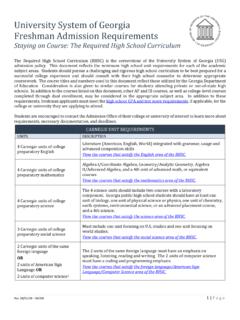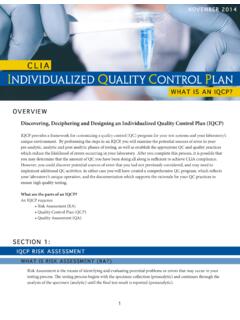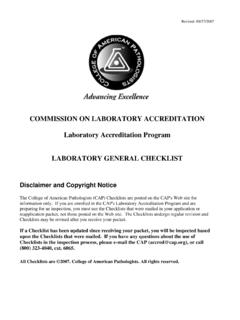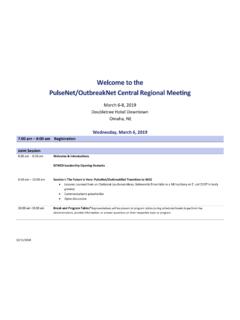Transcription of Clinical Judgment Development: Using Simulation to …
1 Clinical Judgment development : Using Simulation to Create an Assessment RubricKathie Lasater, EdD, RNAbStRACtClinical Judgment is a skill every nurse needs, but nurse educators sometimes struggle with how to present it to students and assess it. This article describes an ex-ploratory study that originated and pilot tested a rubric in the Simulation laboratory to describe the development of Clinical Judgment , based on Tanner s Clinical Judgment Judgment is viewed as an essential skill for every nurse and distinguishes professional nurses from those in a purely technical role (Coles, 2002).
2 Nurses care for patients with multifaceted issues; in the best interests of these patients, nurses often must consid-er a variety of conflicting and complex factors in choosing the best course of action. These choices or judgments must be made specific to the situation, as well as to the patient (Coles, 2002; Tanner, 2006). Educators identify the development of Clinical judg-ment in their students as learning to think like a nurse (Tanner, 2006). Most research on Clinical Judgment has relied on participants responses to cases, portrayed ei-ther in text or videotaped form, or on participants recall of particular situations in practice.
3 Their responses have been analyzed, Using either verbal protocol analysis ( , Simmons, Lanuza, Fonteyn, Hicks, & Holm, 2003) or ob-servation and interviews, with descriptive qualitative or interpretive methods ( , Benner, Tanner, & Chesla, 1996). With few exceptions (White, 2003), most descriptive research on processes of Clinical Judgment has centered on its use in nurses practice rather than on its development in students. A review of the literature identified only one instru-ment that purports to measure or evaluate Clinical judg-ment. That instrument, developed by Jenkins (1985), is a self-report measure in which respondents are asked to identify processes or strategies used in deriving Clinical decisions.
4 Because Clinical Judgment is particularistic ( , beyond specific) and dependent on the situation, the valid-ity of a general self-report measure, especially one used for judging the quality and development of Clinical judg-ment, would be questionable. Recent advances in high-fidelity Simulation present an ideal arena for developing skill in Clinical Judgment . Current technology makes the use of high-fidelity (mean-ing, as close as possible to real) Simulation an excellent facsimile to human patient care, offering extra value to Clinical practice learning (Seropian, Brown, Gavilanes, & Driggers, 2004).
5 To date, no studies have demonstrated the effect of Simulation on Clinical Judgment , but evidence in the medical literature suggests that practice with feed-back, integrated into the overall curriculum, facilitates Clinical learning with understanding (Issenberg, Mc-Gaghie, Petrusa, Gordon, & Scalese, 2005).The purposes of this study were to:l Describe students responses to simulated scenarios, within the framework of Tanner s (2006) Clinical Judg-ment Develop a rubric that describes levels of performance in Clinical Pilot test the rubric in scoring students perfor-mance.
6 The development of a rubric, providing a measure of Clinical Judgment skill, was part of a larger study designed Received: May 14, 2006 Accepted: August 15, 2006Dr. Lasater is Assistant Professor, School of Nursing, and As-sistant Professor, School of Medicine, Oregon Health & Science Uni-versity, Portland, author acknowledges the generous assistance of Dr. Chris-tine A. Tanner ( Clinical Judgment expert) and Dr. Michael Katims (ru-bric expert) in the development of the Clinical Judgment rubric. Address correspondence to Kathie Lasater, EdD, RN, Assistant Professor, School of Nursing, Oregon Health & Science Universi-ty, 3455 SW Veterans Hospital Road, SN-4S, Portland, OR 97239; e-mail: of Nursing EducationLASATERto explore the effects of Simulation on student ap-titude, experience, confi-dence, and skill in Clinical Judgment (Lasater, 2005).
7 LitERAtURE REviEw why a Rubric?A rubric, by its most ba-sic definition, is an assess-ment tool that delineates the expectations for a task or assignment (Stevens & Levi, 2005). By clearly describing the concept and evidence of its under-standing, students and faculty are more likely to recognize it when students perform it. In addition, rubrics facilitate commu-nication among students and provide students, pre-ceptors, and faculty with language to foster both feedback and addition, communication cultivates critical think-ing. By having expectations or stages of development de-scribed and known by nursing students, preceptors, and faculty, the depth of discussion, based on individual per-spectives about Clinical Judgment , increases.
8 Stevens and Levi (2005) pointed out that with the language provided by rubrics and the improved communication that results, faculty may also have additional evidence with which to enhance their , rubrics can provide a more level playing field for increasingly diverse groups of students. It is no secret that higher education, including nursing, is enjoying and is challenged by greater diversity of students related to characteristics such as ethnicity, gender, and experience (Abrums & Leppa, 1996; Brady & Sherrod, 2003; Dom-rose, 2003; Kuh, 2001). Although this diversity enriches the education experience of all involved, the possibility of misunderstanding or lack of clarity about expectations may increase.
9 Rubrics can serve as translation devices in this new environment (Stevens & Levi, 2005, p. 27). Clinical JudgmentThis study used a definition of Clinical Judgment de-scribed by Benner et al. (1996): Clinical Judgment refers to the ways in which nurses come to understand the prob-lems, issues, or concerns of clients/patients, to attend to salient information and to respond in concerned and in-volved ways (p. 2). Tanner (1998, 2006) conducted a com-prehensive review of the research literature and developed a Clinical Judgment Model, derived from a synthesis of that literature.
10 The model (Tanner, 2006) was the concep-tual framework used to develop a rubric that breaks down and defines stages or levels in the development of Clinical Judgment . The Figure illustrates Tanner s four phases of the model Noticing, Interpreting, Re-sponding, and Reflecting describe the major components of Clinical Judgment in complex patient care situations that in-volve changes in status and uncertainty about the appropri-ate course of action. The overall concepts or actions may be summarized as the thinking-in-action skills of three steps: noticing, interpreting, and responding (during the situation that requires Clinical Judgment ), followed by the fourth step, the thinking-on-action skills of reflection after responding to the situation (Cotton, 2001; Sch n, 1987).
